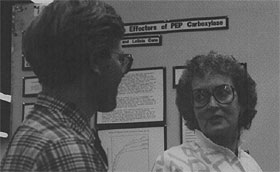Interview: Ruth Satter

Ruth Satter is a plant physiologist whose fascination with plants began with an early interest in gardening. After graduate work at the University of Connecticut, Dr. Satter was a research scientist for several years at Yale University. She is now a professor in residence at the Department of Molecular and Cell Biology at the University of Connecticut at Storrs. Dr. Satter's research focuses on the rhythmic functions of plants, such as the daily leaf movements exhibited by many species. Her imaginative experiments have made her a leader in the field of chronobiology, the study of how organisms measure time and control rhythms.
This interview took place at the 1988 annual meeting of plant physiologists in Reno, Nevada. Between meeting with colleagues, helping her graduate students with their poster sessions, and attending presentations, Professor Satter shared the story of her extraordinary career.
(Note: As this book was going to press, Ruth Satter passed away after a long, brave struggle with leukemia. We will treasure our memories of this remarkable woman who enriched so many lives.)
Ruth, why have you and so many other scientists converged here in Reno, Nevada, this week?
We are here for the annual meeting of the American Society of Plant Physiology. It's an organization of about four thousand faculty members, graduate students, postdoctoral fellows, and undergraduates who are interested in plant research. We meet once a year to learn about the research of our colleagues and to discuss our own research.
How do scientists actually report their work at a meeting like this?
They report their work either by an oral presentation of about 15 minutes or on a display board (of about 4 feet by 4 feet) on which the scientist describes the purpose, the processes, the results, and the significance of his or her research. Individuals attending the meeting then have the opportunity to examine the poster and discuss it with the person whose work it illustrates.
Let's back up and trace the path by which you've come to attend this conference today. How did you begin your college career? Did you major in biology?
I didn't take any biology or botany in college. In fact, I had a double major in math and physics at Barnard College in New York City. After I graduated in 1944, I worked at Bell Laboratories doing research on radar development during the latter part of World War II.
Following your work with Bell Labs, did you go to graduate school right away?
No, after that I married and had children. At that time, child care was inadequate, and opportunities for women to work while they took care of their children were scarce. We had four children and I was out of formal academic life for about 15 years.

Can you recall what induced your return to school for graduate work?
It was something that I had always wanted to do. During my child-raising years, I continued to pursue my intellectual interests. I read books on physics and kept up with new developments. I also became very interested in horticulture. I read books and articles about plant growth and conducted experiments in my own garden. I took courses in horticulture at the New York Botanical Gardens and taught horticulture for an adult education program in Hartford every winter for five or six years.
Your interest in botanical research developed from your home gardening?
Yes, my grandmother stimulated my interest when I was a child. She was an immigrant and had no formal education, but she just had a great curiosity about the way plants grew. She was a natural experimentalist, and her gardening consisted of taking dried lima beans purchased to make soup and saving some of them to plant out in the yard. Or taking potatoes that had sprouted, and cutting out the sprouts and planting them. I worked at these experiments with her and was fascinated by them. These experiences led to my switch from math and physics to the life sciences when I started graduate school at the University of Connecticut.
Was it difficult to change the focus in your life from raising a family to attending graduate school? And what was it like going back to school when you were probably a bit older than most of your peers?
In response to the first part of your question: No, the change was not difficult. Going to graduate school was a real privilege and something that I had looked forward to. It added a whole new dimension to my life. Yes, I was much older than most of my peers, and at that time some of the younger students were not particularly friendly toward the older students. Returning to school was not an accepted thing to do at that time. Of course, I did find some friends, but I was really there because I wanted to learn.
Considering that research support and job opportunities are more ample for animal biologists than for plant scientists, do you ever regret specializing in plant science as opposed to animal physiology?
Never. I have always been so interested in plants. It would never have occurred to me to switch to the animal sciences.
At what point did you become interested in circadian rhythms and the biological clocks?
When I was a graduate student, Beatrice Sweeney, a pioneer in the field of circadian rhythms, gave a seminar at the University of Connecticut where she discussed her research on bioluminescence in certain algae. She showed us data indicating that bioluminescence only occurs at certain times of day, and that if one kept the algae in a constant environment-constant light and constant temperature-these periods of bioluminescence occurred approximately 24 hours apart. I found it fascinating that there was some sort of an internal oscillator or clock that was controlling bioluminescence, and I knew then that at some time in my life I wanted to study circadian rhythms.

So it was the impact of a guest speaker that directed your future research?
Yes. After I received my Ph.D. degree, I had a postdoctoral fellowship at Yale, where I studied leaf movements. Initially, I looked at the effect of light on the movements, but I was most interested in the fact that one had to apply the light stimulus at a certain time of day to get the effect in which we were interested.
Could you describe what you mean by leaf movements?
There are certain plants that have leaves that are horizontal in the daytime and vertical at night. Plants that exhibit these sleep movements are called nyctinastic plants.
How do we know that these sleep movements are not just a response of the plant detecting light and darkness? How can we distinguish between the plant simply responding to an environmental cue as opposed to actually keeping track of time for itself?
To make this distinction, one has to maintain light, temperature, and humidity constant for a long period of time and see whether the movements persist. If they persist in constant conditions, one can assume the movements are probably controlled by an internal oscillator. To be officially called a "circadian" rhythm, the plant must repeat its movement cycle at approximately, although rarely exactly, 24-hour intervals in a constant environment.
Presumably, this internal clock can be adjusted by changes in the environment: by the seasonal changes in the timing of sunrise and sunset, for instance. How does the clock interact with the environment?
This is a very important question because if the clock did not interact with the environment, it would fall out of synchrony with solar day and wouldn't function usefully. Let's use the analogy of a watch that runs fast, for instance: You can either take such a watch back to the store and have it fixed so that it keeps proper time, or you can set the hand of the clock back each day so that you repeat part of the cycle. The latter method is the method that organisms use to adjust their rhythms to solar light. Every day at the transition between light and darkness, at dawn and at dusk, the environmental cue resets the clock.
Do you have any ideas on the mechanism by which the clock works?
Unfortunately, we really don't know how the clock works, but if we understood how the clock is reset, we would know a great deal about the clock mechanism. We are now looking at the complex series of events between perception of the light signal and resetting of the clock. We are approaching this in several different ways. First, we are looking at biochemical changes. After the light signal is detected, there are certain changes in biochemical compounds in membranes of cells. Our hypothesis is that these biochemical changes lead to changes in the amount of calcium within the cell and in the activation of enzymes, called kinases, that phosphorylate proteins, and that changes in calcium and phosphorylation change the properties of membrane transport proteins.
How does the plant actually move its leaves? Does it have something like muscles?
At the base of each leaf or leaflet is an organ called a pulvinus, which looks like a horizontal cylinder in the daytime but curves to form an inverted U at night. The changes in curvature of the pulvinus cause the leaf to move. The blade doesn't change; it's just the pulvinus that curves.

What causes the pulvinus to curve?
When the pulvinus is horizontal in the daytime, cells on the underside are swollen and those on the upper side are shrunken. In the nighttime, when the pulvinus curves, cells on the upper side swell and the under cells shrink. Changes in the size of the cells depend upon changes in the amount of potassium, chloride, and other solutes within the cell. When the cell takes up potassium, chloride, and other ions, water moves in by osmosis and the cells swell. When the cells lose these ions, water moves out of the cell through osmosis and the cell shrinks.
Do you have any speculations as to the possible function within the plants of these sleep movements?
Charles Darwin suggested that sleep movements help plants conserve heat at night, but this is not the whole answer. Perhaps someone in the young generation of biologists just beginning to study biology will answer this question.
Are there any connections between the circadian rhythms in your plants and those in humans and other animals?
The basic principles that govern rhythms in plants, animals, and microorganisms are very similar, but we don't know whether or not the clocks that generate the rhythms function in the same way. Most people don't realize that our first evidence for biological rhythms came from studies in plants. In the year 1729, a scientist named DeMairan conducted a very simple experiment. He knew of certain plants with leaves that are horizontal in the day and vertical at night. It had been generally assumed that light and dark caused the movements. DeMairan put one of the plants on his windowsill and one in his basement, where the light was very dim but of constant intensity; perhaps he used a candle in those days. He found that the movements persisted in the plant that was in constant conditions as well as in the one that was on the windowsill. From these results he predicted that there had to be an internal oscillator in plants, and he speculated that animals also have internal oscillators. It took 200 more years, however, before there was any solid evidence for rhythms in vertebrates. We now know that all eukaryotic organisms probably have clocks of some kind.
Do zoologists who work on circadian rhythms and botanists who study rhythms in plants now have much interaction?
Yes, they meet together every year or two at special chronobiology conferences where they read about each other's research and discuss ideas. They learn from one another.
How do you define chronobiology?
Chronobiology indicates time measurement by an organism.
You describe your work as basic research in the sense that you are investigating a basic biological process rather than searching for any kind of specific applications. How is basic botanical research related to agriculture?
We need to understand fundamental botanical processes in order to make improvements in agriculture. In my own research, for instance, although our study of time-keeping processes seems very theoretical, it has a practical application. A large number of processes in many plants occur at close to the same date each year. These include the time at which a plant switches from vegetative growth to flowering, and the time at which certain trees begin processes that will eventually lead them to become dormant in the winter. The plant has to have some environmental cue to synchronize its growth with changes in the external environment; a change in the length of the dark and light periods is the most reliable cue. For instance, spinach is a plant that grows vegetatively in the spring and flowers during the long days of summer. By knowing this, one can manipulate day length artificially and grow several crops during the year instead of just growing one. Understanding how the plant measures time should have additional practical benefits, possibly by genetic engineering to alter the plant's photoperiodic requirements.
Students read a lot today, even in the newspaper, about genetic engineering and possible applications. What promise does genetic engineering hold for agriculture?
At this particular time, genetic engineering is helping us to understand a lot of basic processes. This includes learning more about how the photosynthetic machinery works, why some plants survive periods of unusually low temperature whereas other plants don't, why some plants are more tolerant of high temperature than others, and why some plants are resistant to pathogens such as viruses, bacteria, and fungi while others are not. We are beginning to discover this information through genetic engineering techniques. There certainly will be many practical applications in the future.
With all of the present problems of regional famine, do you see any special opportunities and responsibilities that plant scientists in developed countries have toward alleviating these problems?
We have a very great responsibility to do just that. We have the technical ability, the educational facilities, and the capital, and we certainly should use our scientific resources as wisely as we can to help prevent famine in other countries. This would include both bringing scientists from other countries here for training and sending some of our people to their countries. It also includes focusing research on nutritionally important crops like rice, beans, and corn.
This all requires money. Could you tell us about research grants and how one goes about getting them?
The application process for a research grant is highly competitive. It requires a description of the proposed research, the experimental plan to be followed, and an indication of the potential application of the research. The proposal then is sent to a funding agency composed of a panel of experts who determine which proposals to fund. The two largest funding agencies are the National Institutes of Health (NIH) and the National Science Foundation (NSF). Both are supported by the United States government. Plant research is also funded by the Department of Agriculture.
Let's imagine a young professor who is just out of graduate school or has just completed postdoctoral work and is starting a faculty position at a university with a major research program. What kind of a situation would he or she actually walk into in terms of facilities and how would the young professor go about getting started?
A young professor would have a problem that he or she is interested in addressing and would think of the important questions posed by that problem. The professor would hope that the university would help initially by providing some equipment and money for supplies. Basic research would be conducted to indicate whether the methods and the project as a whole are feasible. Then the professor would write a grant proposal and submit it to one of the agencies that supplies funding. The long-term survival of each research program depends upon obtaining outside funding.

Are you provided with not only lab space but also space in which to grow your plants?
Yes, my university provides us with both greenhouse space and space for growth under controlled conditions. If I were working on crop plants, I would also be given study fields.
How do you obtain the exotic plants with which you work, such as Samanea?
I first obtained the seed for Samanea while vacationing with my husband in the Virgin Islands. We looked at the various plants with moving leaves and found one that had a very large pulvinus. I asked the person who owned the tree if I could have some seeds. After that, I found out that the plants grow near the botany building at the University of Hawaii. A fine friend sends me seeds each year.
Training graduate students and postdoctoral students is a very important function of the university professor. About how many students of various kinds have you had in your labs over the years, and how do you select them?
Close to two dozen. I like to include undergraduate students too, most of whom initially find me. They usually come looking for jobs, sometimes to earn money by washing glassware or doing other routine tasks. When they are in the lab, I can determine whether or not they are reliable and are truly interested in our work. If so, I encourage them by including them in our research. Some have done publishable research. Two undergraduates presented posters at regional meetings of the Plant Physiology Society this year. One of them has been the coauthor on two papers. Another is in the process of writing a paper now.
Could you describe the social environment in a lab that includes you as the principal investigator, graduate students, one or two postdoctorates, and an undergraduate student?
There is a lot of interaction and sharing. We try to have lab meetings once a week. People discuss their research. They give each other ideas and they stimulate each other. The professor should provide a laboratory environment that encourages students to learn and ask questions, to think critically, and to challenge dogma. When a student criticizes an idea, I feel that he or she is growing up. The students must understand that research involves a lot of discipline and hard work. They should also find it stimulating, exciting, and fun. They should learn that they can challenge me and that I learn from them as they learn from me.
What qualities do you look for when choosing students or postdoctoral researchers for your lab?
Intelligence. Dependability. Diligence. Dedication. It is very important that the student be enthusiastic about our work. And hopefully he or she has a real passion for learning. I look for people who will contribute to the enjoyment of researching and learning. It is important that the person be cooperative, honest, and willing to admit to making mistakes. If a student tries to hide mistakes, I really don't want to keep him or her.
You mentioned earlier that you were very much influenced by a seminar given by Beatrice Sweeney, a woman working in the area of circadian rhythms. Today though, there are still far fewer women in science than there are men. Do you have any recommendations as to how we can attract more women to careers in science?
The gender gap is much smaller today that it was a decade ago. But there are a few basic problems. A generation or two ago it was very difficult for a woman to have a career in science. Opportunities were very limited, and science in many institutions was a male enclave. Barriers are breaking down, but it will take a while before the break is complete. Consequently, there are not enough older women in science to act as role models. I think that the situation will continue to improve, resulting in a more comfortable environment for women.
Also, a career in science is very demanding, particularly if one is at an academic institution where one is required to teach, keep up with modern research, read journals, and understand how the field is progressing. Science is changing rapidly, and staying abreast of these changes is time consuming. Many young women are concerned that it would be difficult to find time to raise children and lead a normal family life. To women who want a career in the sciences, I would say: You can have it all. It takes a lot of dedication and possibly a readjustment of priorities at certain times of your life. You will have years during which you may not be able to concentrate on your science as much as you had hoped, but you can make up for that at some later time. Don't give up easily. If you are interested in science, pursue your dream. Universities can help by providing child care at the workplace and flexible work schedules.
How early do you think students need to develop the confidence that they can succeed in science?
The earlier the better, of course. If they develop it as children, they are better off, but they can develop it in college or in graduate school.
What advice or recommendations would you give to a college freshman who is just starting a curriculum in biology or, even more generally, in science?
If you find an aspect of science that interests you particularly, identify the faculty members at your university who are working in this area. Go to see them, visit their laboratories, express your interest, and ask if you can do any work in the laboratory, even if it just involves washing glassware. While there, you will come into contact with people working in the lab and will have the opportunity to talk with them about their work. Express an interest and an enthusiasm. I think that relatively few faculty members will turn down an enthusiastic student. In fact, they will encourage you to become more involved.
©2005 Pearson Education, Inc., publishing as Benjamin Cummings